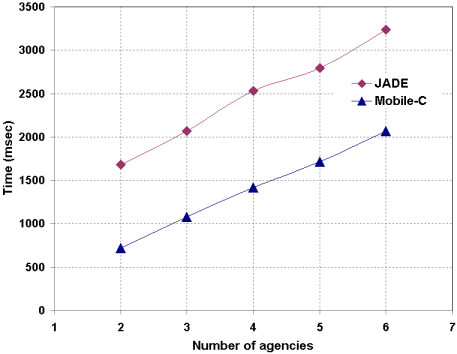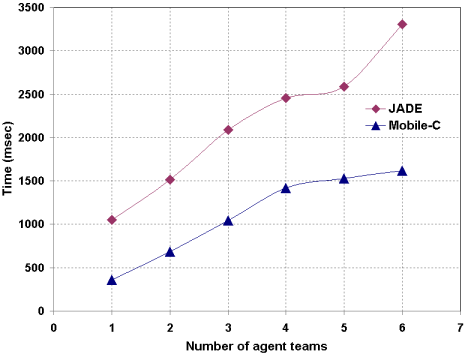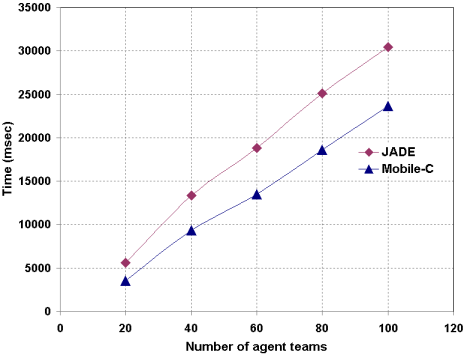



|
Performance Analysis:
Agent Migration Performance




The agent mobility of a mobile agent platform is relevant to and affected by the agent migration performance of that platform. The performance of agent migration is specifically important to applications with a large number of mobile agents. Here presents performance comparison of agent migration for Mobile-C and JADE using three essential benchmark tests originally proposed for JADE. Each of the three experiments simulates a relay-race. Interactions between any two runner agents in the same team are accomplished by exchanging ACL messages. A homogeneous environment is set up to perform the tests. The environment consists of four identical Linux machines. Each machine has an Intel Pentium 4 processor running at 3.2 GHz and 512 Mb of RAM. All these machines are connected through a switch with a 100 Mbits/s transmission rate. Test 1: Four agent teams with different numbers of agenciesThe first test is where four agent teams migrate among different numbers of agencies. The number of agencies ranges from two to six. For situations where there are two to four agencies, each machine has one agency running on it. For situations where there are five and six agencies, there are two machines that have two agencies running on them. The migration routes for five and six agencies are set up in a way that no agents will migrate between two agencies running on the same machine. Each team has one trigger agent and the same number of runner agents as that of agencies. For each team, at the beginning, each runner agent stands by on each agency. The trigger agent is then sent to the first agency to signal the runner agent to start the relay-race. The trigger agent becomes another runner agent once it signals the runner agent to depart from the first agency. In order to make all the runner agents leave the first agency almost simultaneously, a trigger agent does not signal its runner agent until all the other trigger agents arrive the first agency. Each team is considered to complete one lap when the runner agent on the last agency arrives the first agency. A total of five laps need to be completed by each team. The moment when all the trigger agents arrive the first agency to start the first lap is recorded as the start time. The moment when all the runner agents on the last agency arrive the first agency to complete the fifth lap is recorded as the stop time. A migration time is calculated as the interval between the start time and stop time. Figure 1 shows the migration times of Mobile-C and JADE for test 1. Each migration time is obtained by averaging 20 migration results. The migration times of Mobile-C are about 42.55%, 51.96%, 55.96%, 61.35%, and 63.79% of the corresponding ones of JADE for two to six agencies. The results also show that the performance of Mobile-C is more linear than JADE. 
Figure 1: Migration times for four agent teams with different numbers of agencies. Test 2: Four agencies with different numbers of agent teams The second test is where different numbers of agent teams migrate among four agencies. The number of agent teams ranges from one to six. Each machine has one agency running on it. Each team has one trigger agent and four runner agents. The methods for starting the relay-race and calculating a migration time are the same as those in test 1. Figure 2 shows the migration times of Mobile-C and JADE for test 2. Each migration time is obtained by averaging twenty migration results. The migration times of Mobile-C are calculated to be 34.61%, 45.24%, 50.02%, 57.73%, 58.9%, and 48.94% of the corresponding ones of JADE for one to six agent teams. 
Figure 2: Migration times for four agencies with different numbers of agent teams. Test 3: Four agencies with large numbers of agent teams The third test is the same as test 2 except that large numbers of agent teams are involved in the relay-race. The numbers of agent teams in test 3 are 20, 40, 60, 80, and 100. Each machine has one agency running on it. Each team has one trigger agent and four runner agents. The methods for starting the relay-race and calculating a migration time are the same as those in test 1. Figure 3 shows the migration times of Mobile-C and JADE for test 3. Each migration time is obtained by averaging twenty migration results. The migration times of Mobile-C are calculated to be 62.46%, 69.87%, 71.8%, 74.01%, and 77.82% of the corresponding ones of JADE for 20 to 100 agent teams. 
Figure 3: Migration times for four agencies with different large numbers of agent teams. Source codes for migration tests Source codes for Mobile-C Source codes for JADE |
| Integration Engineering Laboratory | UCD MTU Sandia |